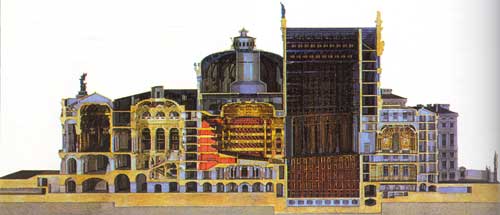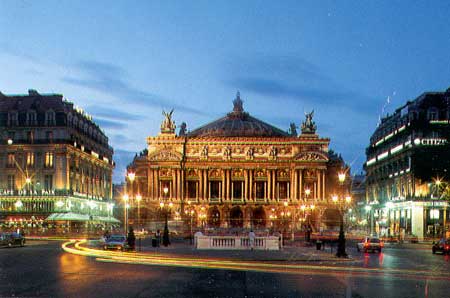Opéra Theater, Paris
-
Time of construction: 1861 - 1875
-
Location: Paris, France
Opéra theater - today renamed Palais Garnier to pay homage to the architect of the theater design - is one of the most prominent buildings in Paris. When Napoleon III and the South Haussmann planned in the city in 1852, along with the wide boulevards and straight-line views, they placed an answer to the main building in unified places with the overall design. can. The Opéra theater on an island is a confluence of the main roads, which is such a point.

Model of the cut surface peeled Opéra theater, in the Orsay Museum Museum:
The auditorium praised both the public and the performers.
Note the impressive proportions and Garnier's large stair layout in the middle.
The selection of architects by public bidding, held in 1860, received anonymously. When the referees decide who is chosen, they themselves are surprised, turned out to be an almost unknown young man - Charles Garnier, 33, graduated from the École des Beaux-Arts and the Academy France in Rome. He has no experience, but according to his instinct to grasp the requirement: The project must perform effective functions in view of the audience and performers, while showing the richness and enjoyment at every show. in the Opéra theater.
Concept
As a starting point, Garnier chose the most admired theater in Europe, Victor Louis's Grand Théâtre. This magnificent neoclassical work, started in 1773, belongs to the first building to turn the theater into an important memorial of the masses. Visitors first step through a large hall into the staircase leading to the upper floors with seats and create a comfortable travel space during recess. The auditorium is covered with a roof-shaped ceiling that rests on a column circle. Garnier completely adapted this scheme but expressed in the new Baroque style, not in the neoclassical "language" .

Opéra theater on an island is a confluence of
Main roads (Photo: westminster)
His staircase was even bigger and filled with luxurious curves, the closer he got to the seat, the more impressed the audience felt with the richer decoration. Floor of multicolored marble balustrades, columns of women, columns and stairs create a spectacle of delight, especially when each of the 4 floors is filled with spectators in every night. In the auditorium, Garnier improved his vision by focusing on the supporting columns in pairs at the corners rather than in a circle.
Backstage facilities are also streamlined, with a rehearsal stage at the back, creating a balance for the whole project. The emperor was given a private entrance on one side (partly for security reasons)

Each surface shows the typical decorative look very familiar: this is a mosaic panel on the ceiling that touches the exterior of the corridor facing the Place de I'Opéra.
security was almost assassinated when he entered the old Opéra theater), while the other side had a small museum. The grandiose appearance of the entire theater actually brings satisfaction to the rationality and aesthetics.
Actual data:
-
Area: 11,237m 2
-
Length: 97m
-
Width (maximum): 125m
-
Height (calculated from Apollo's lyre foundation); 73.6m
-
Large staircase: 30m high
-
Audience room: 20m high, deep: 32m, wide: 31m (maximum), 2,200 seats
-
Hanging fort: 8 tons
Interior
In the interior, the layout and materials serve different purposes, while the overall effect of fine floral decorating efforts creates a strong feeling throughout the theater. Before Garnier, marble and mosaic materials were not the familiar materials of Parisians . Garnier searched throughout Europe, even digging back the ancient quarries to get the precious materials needed. Once he had enough marble, he persuaded his sculptors to recreate the image of the classic cannon and the female statues and bust, combining a variety of colored marble. Different colors in the same work so that the multicolored effect does not fade over time.
Although much decorated, Garnier had to negotiate many contracts and come up with new techniques to control costs. Traditional hand-inlaid mosaic materials that have to be arranged "face- down " on paperboard, then covered with a thin layer of mortar, then put into the panel.

The great sculpture The Dance of Jean-Baptiste Carpeaux was insulted by many people at the time, but Garnier was perfectly reasonable in supporting his sculptor (the original statue is now located in the Orsay Museum).
Garnier's research shows that only a few decorative surfaces capture the light needed to accentuate the gold plating color, while other surfaces simply paint in shiny yellow tones. Instead of covering expensive bronze statues, Garnier uses electrolytic processes that require much less material.
Much of his talent lies in deciding the size, cross-section, color palette and theme he wants for a surface or sculpture, then he lets the artist he has recruited to choose the idea. own. At that time both decided the final component. While Garnier was elegant and persuasive, he had only a few opportunities and selected the most capable painters and waiters, who had attended the same school as Beaux-Arts and Prix de Rome.His selection of Jean Baptiste Carpeaux made his sculpture called The Dance clearly demonstrating his confidence as a designer . The last proposal of talented and stubborn Carpeaux dismissed Garnier's original idea and even made a lot of notoriety when discovered, Garnier insisted on protecting the famous sculptor and the history of assertiveness. his clothes.
Garnier's legacy
Garnier understands originality and is proud of this. When Queen Eugénie complained she could not know what style the theater was built - "is it according to Henri IV or Louis XIV or Louis XV?" - Garnier replied: "This style follows Napoleon III". His comment must be regarded as his own, first of the importance of his client's strong support, the second of the reality of the collective effort of a team of talented artists. The ability to work under his direction.
The theater is not an architectural work for intellectuals to contemplate, but a construction for fun and entertainment . Architecture like entertainment, the Opéra theater is one of the first demonstrations of a growing nouveau-riche society, the expression of interest is probably not analyzed - confident of yourself, ready to receive any any challenge. After the inauguration for more than a century, the Palais Garnier's miracle remains intact.

Garnier's original multicolored facade, greatly improving the appearance of the Opéra theater.
(Photo: cybevasion)
- A tour of the world's most beautiful cinemas
- Discovering a huge ancient Roman theater in England
- Discovering a Roman theater with a capacity of 15,000 people
- Accurate prediction of the tragedy in Paris
- Close-up of Paris city
- The gold coin jar buried more than 1,500 years under the Italian theater
- The beauty of Paris through a bunch of photos taken over 100 years ago
- Admire the theater masterpiece of the ancient Greeks
- The 5 most mysterious legends in the magnificent city of Paris
- The secret of the magic transmission ability of the Greek theater
- Ancient theater from Roman times was discovered in Volterra, Italy
- Horror 'storm' mouse tribute to the capital of Paris
 Norway built the world's tallest wooden tower
Norway built the world's tallest wooden tower Kremlin
Kremlin Ashurbanipal: The oldest royal library in the world
Ashurbanipal: The oldest royal library in the world Decoding the thousand-year construction of Qin Shihuang shocked the world
Decoding the thousand-year construction of Qin Shihuang shocked the world